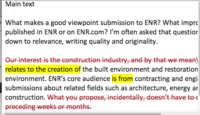
Richard Korman
Too often discussions of public spending on transit and commuter rail leave out the full political context. So, it was good to hear Jamie Torres-Springer, construction unit president of the New York City Metropolitan Transportation Authority, describe at ENR’s N.Y-N.J Infrastructure Forum the indefinite pause in June by state Gov. Kathy Hochul (D) of the city’s vital congestion pricing plan as the “elephant in the room.”
Addressing event attendees Sept. 16 in Manhattan, he said he took Hochul “at her word” that she will either restore the plan in some form or find other means to come up with $15 billion the congestion plan was set to provide to MTA’s capital spending program.
Since Hochul’s 11th-hour cancellation of a plan that was to take effect June 15, her motives have become even clearer: regaining control of the U.S. House of Representatives for the Democrats. That control is critical to the future of both major political parties and their agendas.
It’s why Republican presidential contender Donald Trump held a Sept. 18 rally in Nassau County, Long Island. He is unlikely to carry New York in his White House bid, but the down-ballot races in New York City suburbs, including a contested seat in my Hudson River Valley congressional district, are very vital to both parties’ agendas. Hochul isn’t up for re-election but to turn out voters who will support Democratic candidates, she is lending resources that include 37 field offices and 100 staffers, reports the New York Times.
Under the congestion pricing plan, most drivers entering Manhattan south of 60th Street would be charged a $15 toll.
I got a small taste of the hot-button congestion pricing issue after riding a commuter bus home from the ENR event. Pasted on the back of the divider behind the bus driver’s seat that faces passengers, was a poster stating, “Your Bus Fare Is At Risk.” Congestion pricing, the poster text explained, could drive up the price of a bus ticket unless buses are exempted.
A one-way ticket to my town from the city bus terminal, if bought with no volume or senior citizen discount, now costs $12.50. Those busses are important to many of my neighbors—and even at that high price—are a vital link for those who can’t afford to own cars or pay the parking, toll and gas costs that come with any automobile trip. In my understanding, congestion pricing would have exempted or partly exempted commuter busses even though they now carry fewer passengers than before the pandemic.
After a quarter century of bus commuting, I now drive into midtown and downtown Manhattan when I need or want to be there— and between garage fees and tolls, the trip rarely ever costs less than $50. Even without the cost of parking, suburban commuters could each year face several thousands of dollars of higher commuting costs under congestion pricing.
That much said, a revised plan for the metro area transit system, especially the subway, is not something that should be ignored until Election Day is over. It needs to be prepared now to be ready to roll out soon after Nov. 5.
Subways are too important. The system in Tokyo runs more smoothly and efficiently to connect that sprawling city of 14.2 million people better than does the one in New York City. The system in Seoul, South Korea, is comparably more quiet and cleaner. I’ve ridden them both. Those systems also are perceived as safer than in New York City, where despite new anti-crime initiatives introduced since 2022 and an incident rate decline last year, fare-beating still drains operating revenue and violence somewhere in the system is up so far in 2024, says The Times.
But neither is that system a dismal failure or a hopeless mess as has been portrayed. Essential Living, a London real estate firm, ranks it first globally in stations, track miles and train speeds. The subway also is rated most convenient based on its 24/7 operation.
But a transit system soon set to mark its 120th anniversary clearly needs major renovation and service improvement investment. Its 65 miles of elevated track and hundreds of miles of underground track are in “poor and marginal condition,” said Torres-Springer, with $9 billion set for critical structures repair, including paint or waterproofing of 45 bridges and viaducts. Spending on elevators also is vital.
The subway is the river on which the lives of millions of residing and working New Yorkers and city visitors flow. Towers that honeycomb Manhattan skies are not the city’s signature; it is the iconic subway’s underground trains. Whichever party wins the House majority, New York City needs a revised congestion pricing plan—and soon.
Deputy Editor Richard Korman is an opinion editor of ENR.





